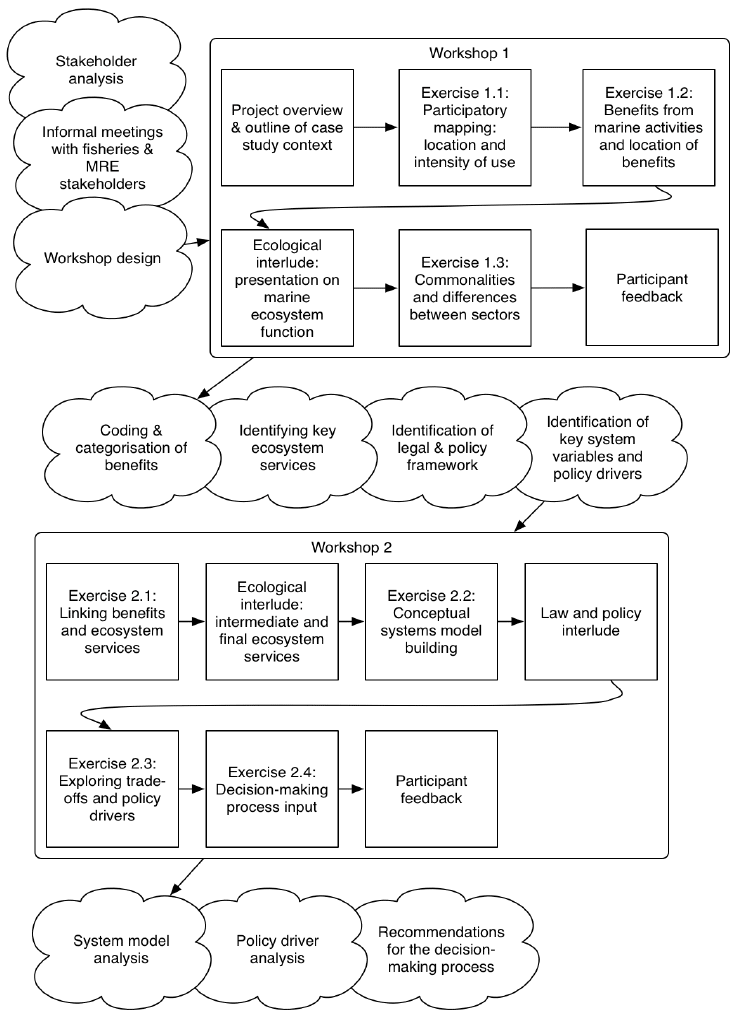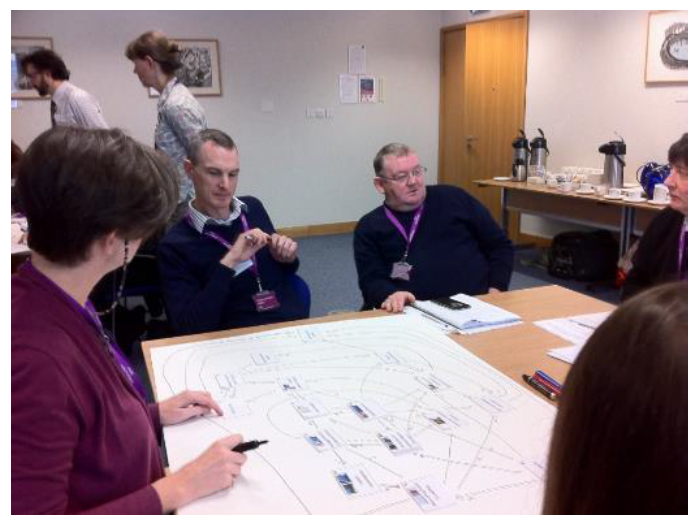The Cooperative Participatory Evaluation of Renewable Technologies on Ecosystem Services (CORPORATES): Scottish Marine and Freshwater Science Vol 7 No 1
This report provides the background, the process and the outcomes of an interdisciplinary project entitled “The Cooperative Participatory Evaluation of Renewable Technologies on Ecosystem Services: CORPORATES”, funded by the UK Natural Environment Resear
Executive summary
Background and aim
1. This report provides the background, the process and the outcomes of an interdisciplinary project entitled "The Cooperative Participatory Evaluation of Renewable Technologies on Ecosystem Services: CORPORATES", funded by the UK Natural Environment Research Council ( NERC). The aims of the project was to exchange knowledge between researchers and a range of public and private sectors stakeholders around the understanding of marine ecosystem services ( ES), in the context marine spatial planning ( MSP) decisions around marine renewable energy ( MRE).
2. The project developed a pilot study located at the Firth of Forth, Scotland, considering current development of a number of large windfarms in an area important to both fishing and nature conservation. The project included the involvement of a wide range of highly experienced stakeholders over the course of two day-long workshops in November 2014 and March 2015.
3. While the process centred on a 'live' decision-making case study, the focus of the CORPORATES project was to provide an example of a decision support tool for knowledge exchange around ES rather than influencing decision-making in the Forth.
4. The project design and delivery was highly transdisciplinary, involving experts with backgrounds in ecology, oceanography, marine management, policy, law, environmental psychology, anthropology and ecological economics as well as public and private sector stakeholders.
Methods
5. MRE industry representatives and regulatory/advisory partners were brought together with representatives of fishing organisations, non-governmental organisations ( NGOs), tourism operators, recreationalists, and local government.
6. The pair of workshops (Figure 1) introduced the concept of ES and linked these to the activities of, and benefits derived by, all stakeholders from the supply of these ES in the case study area. The workshops included the following components:
i. Sectoral representatives (fisheries, conservation and recreation) mapped areas and activities of importance to their sector and then shared their maps across sectors, allowing everyone using the environment to show their areas of interest to each other (1 st workshop).
ii. Short knowledge exchange interludes on ecology, oceanography, law and policy were used to create a shared baseline of ecological and policy knowledge (1 st and 2 nd workshop) and a context for decision makers.
iii. The sector groups created lists of benefits derived from the mapped activities and these were compared amongst the different sectors to identify commonalities as well as differences (1 st workshop).
iv. The benefits identified by stakeholders were grouped by the research team (in between workshops) into broader categories which were then associated with three key ES (following UK NEAFO [1] conceptualisation): fish & shellfish, climate regulation and seascape. Four key features were also identified that could be linked to these benefits: Degree of naturalness, wildness and vastness, habitat diversity, species diversity, number of cultural/historical features.
v. Participants from different sectors worked together in small groups to link the different categories of benefits back onto the three key ES of fish & shellfish, climate regulation, and seascape (2 nd workshop).
vi. Each mixed sector group created their own conceptual system model ( CSM) in order to explore interactions and feedbacks between ecological processes, ES and associated features, benefits and activities/actions. The development of the CSM started from ecological processes that constitute the base of the food chain up through species and habitat diversity to ES, benefits and activities such as current fishing, future windfarm development, and MPAs and showing the links between all these aspects (2 nd workshop).
vii. Using their CSMs as a starting point, the mixed groups discussed potential impacts of policies concerning fisheries (Common Fisheries Policy [ CFP], establishment of Inshore Fisheries Groups), climate change (Renewables Directive, 2030 Climate Framework) and conservation (Marine Strategy Framework Directive [ MSFD], Natura 2000 regulations) on the different activities and benefits in the area (2 nd workshop).
viii. Written narratives allowed individuals to express their personal opinions and beliefs regarding possible future changes to ES-benefits-activities (2 nd workshop).
Figure 1. Outline of the CORPORATES methodological process.

Results and discussion
7. Formal and informal feedback indicated that the first workshop was deemed moderately successful. The second workshop was highly successful in the eyes of participants, who specifically mentioned such aspects as gaining knowledge on a range of topics, quality of discussion and workshop delivery.
8. During the first workshop, more than 100 ES benefits were generated across the different sector groups. Sharing and discussing the sector-specific lists of benefits in mixed groups allowed for a recognition that the different sectors valued many of the same benefits. For example, commercial fishing groups were similar to recreational groups in saying that they enjoyed personal well-being from being at sea.
9. Participant feedback indicated that the process of working in mixed sector groups of stakeholders to link the categories of benefits to ES had been useful to help understand how ecosystem services and benefits interrelated.
10. Although the CSMs were challenging to participants and time consuming, more than 90% of the participants said that they had learned something valuable from this exercise. Working in mixed sector groups, with most of the same people that had met in the 1 st workshop, allowed cross-sector realisation that most other sectors understood and agreed with the linkages being drawn between ecological issues and the range of potential positive and negatives effects at the level of ES.
11. The CSMs were also helpful when the focus shifted from the more abstract level to the concrete issues of the potential consequences for the sectors of different future policy scenarios (in relation to the CFP, Renewables Directive, 2030 Climate Framework, MSFD and Habitats Directive). Throughout the process, there was explicit acknowledgement that the current regulatory framework is complex. Part of the knowledge exchange delivered by the project was recognition of both the ecological complexity and the multiple relationships between law, policy and the environment.
Conclusions
12. The project incorporated cooperative learning and shared development into the creation of a decision-support system. The system was found to be highly relevant to energy developers, fishing organisations, NGOs and tourism businesses, government regulators and policy makers as well as community-level stakeholders. This process built a greater and shared understanding between developing industries and existing stakeholders of the ecological and policy interlinkages and interactions between different ES, benefits, activities, and economic, social and cultural values.
13. The feedback from the workshops affirmed that this process - which placed ES and ecological trade-offs at the heart of the discussion - was helpful in increasing understanding of these issues between a wide range of stakeholders. It enabled joint sector deliberation, as required by law, and showed this can be done in the context of an ES framework. Consequently, the combination of deliberative techniques as worked through in the workshops can help to facilitate planning of marine uses in the face of uncertainties, and may reduce the risk of conflict.
14. A conclusion from the consultation process with stakeholders post the workshops suggests that this decision-support system would be most helpful early in the planning process. The CORPORATES team are currently preparing to provide a workshop on training Marine Planners on how to provide this this approach in 2016.
Image 1. Stakeholder discussion in workshop 2, exercise 2 during the construction of the conceptual system model depicting the ecosystem and human activity in the Firth of Forth Scotland.

Contact
There is a problem
Thanks for your feedback